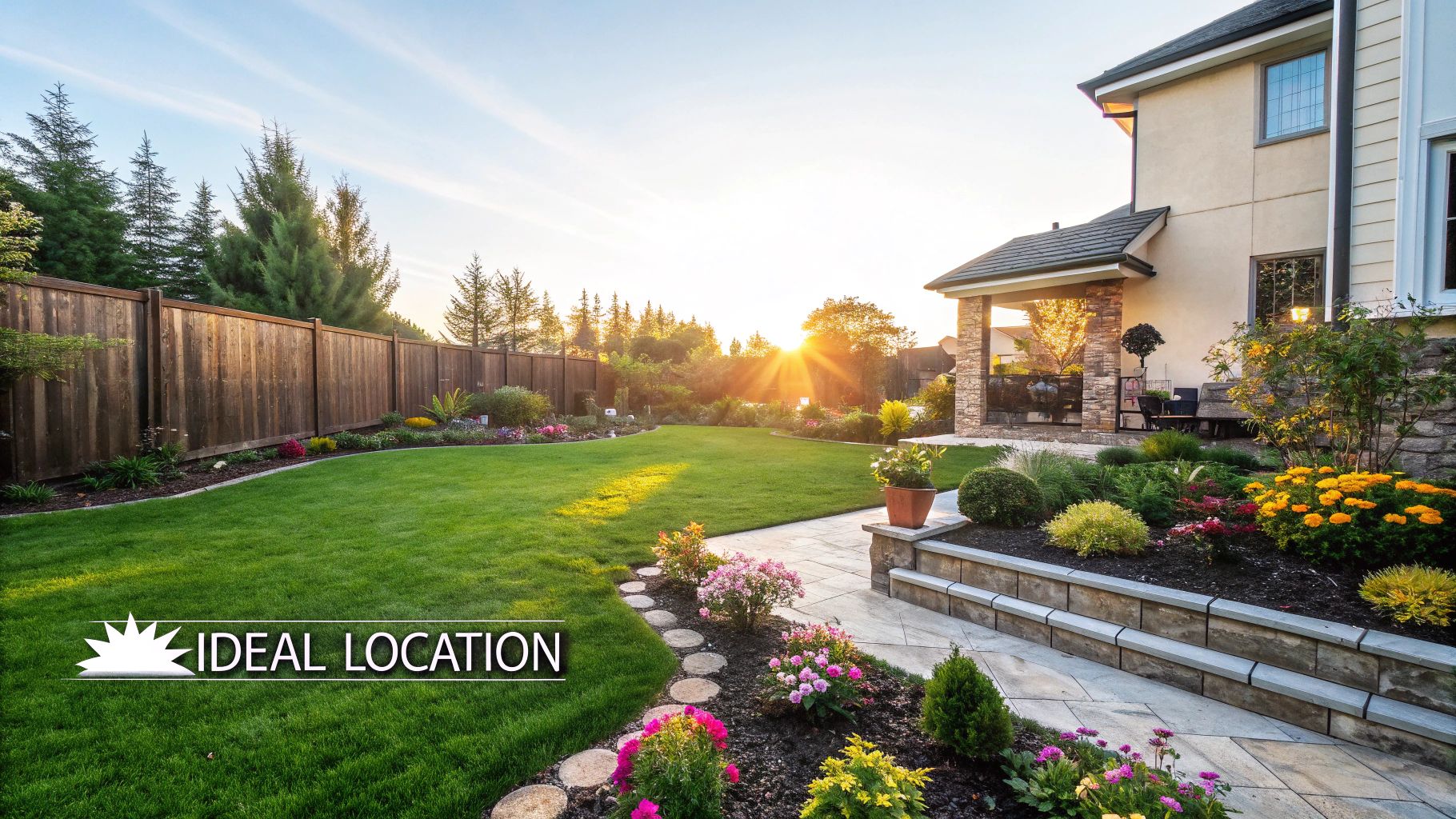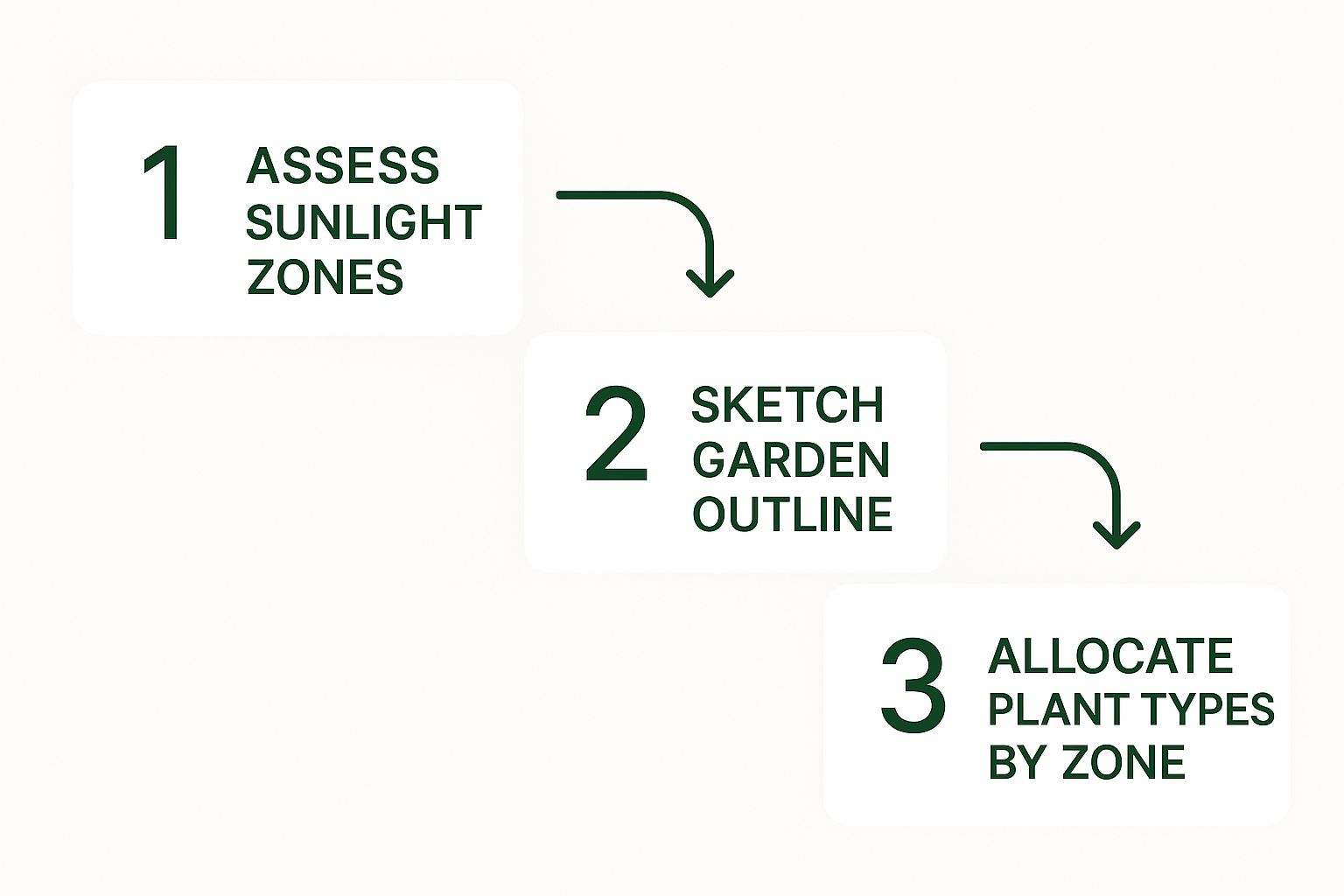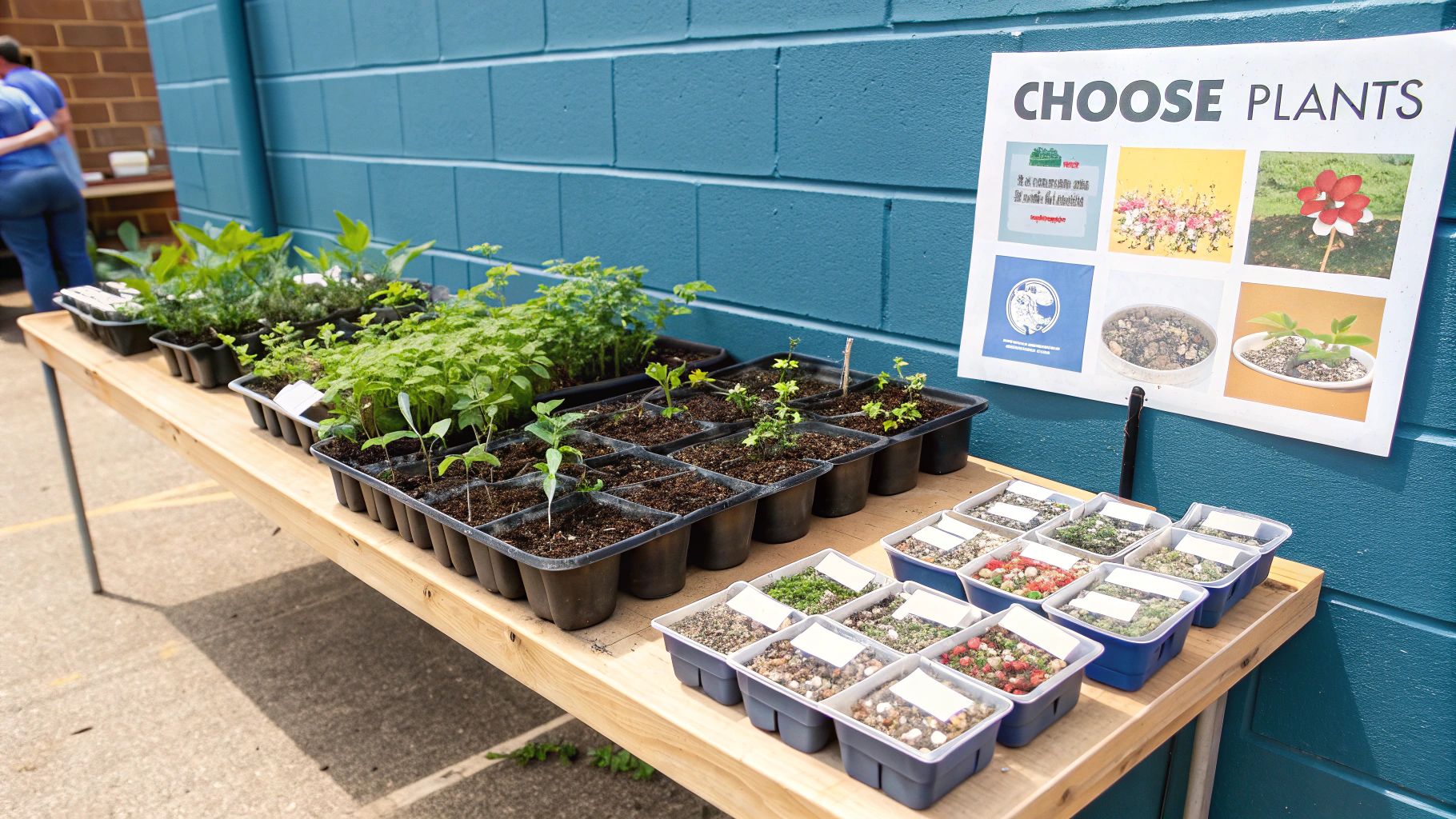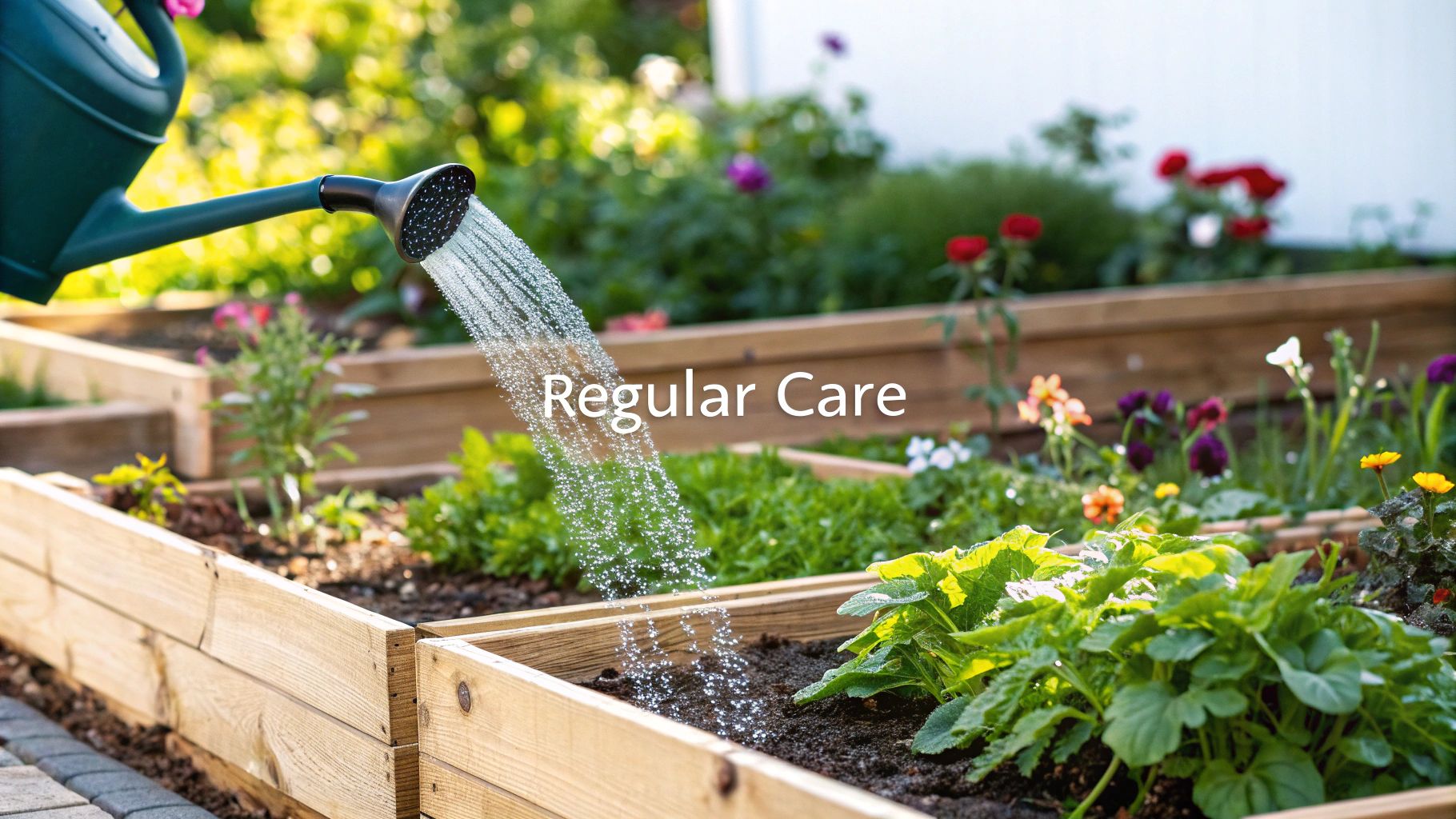
Reading Your Garden Space Like a Detective
Before you get swept away by a gorgeous catalog photo, it’s time to do some detective work. The most successful gardeners I know have learned to read the clues their yard is already giving them. This is the secret to planning a garden that cooperates with your environment, not one that constantly fights against it. Think of yourself as a landscape detective, about to crack the case of your own backyard.
This whole process is about swapping random plant purchases for a garden that actually works together. It means noticing the little things—like that one patch where the morning frost always melts last, or how the area by the brick wall feels ten degrees warmer in the afternoon. These observations are your first real steps toward creating a garden that feels less like work and more like magic.
Decoding Your Local Climate and Microclimates
Your first big clue is your regional climate, which is usually summed up by a hardiness zone. This number tells you the average lowest winter temperature for your area, which is essential for choosing perennial plants that will come back year after year. For example, if you live in Zone 5, a beautiful plant rated for Zone 7 probably won't survive the winter chill and return next spring.
This map gives you a good look at the USDA Plant Hardiness Zones across the United States.

While the zone map is a great starting point, the real discoveries happen when you identify the microclimates in your own yard. A south-facing wall can bake in the sun, creating a warmer zone perfect for heat-loving herbs like rosemary. At the same time, a low-lying, shady corner might be the perfect home for delicate ferns.
Mapping Your Sun and Shade
Sunlight is the engine of your garden, and understanding its daily and seasonal journey across your property is a must. A tomato plant that needs 6-8 hours of direct sun will just pout and refuse to produce if it only gets a little morning light. To get this right, you just need to spend a day being a sun-stalker in your own yard.
- Sketch a simple sun map: Just a basic layout of your yard on a piece of paper is fine. No artistic skills are needed!
- Check in every few hours: Start in the morning and make notes of which areas are in full sun, partial sun, or deep shade.
- Track the sun's path: I like to use different colored pencils to mark the sun's position at different times (e.g., yellow for 9 AM, orange for 1 PM, red for 5 PM).
This quick exercise will give you a surprisingly accurate map of your "full sun," "part sun," and "shade" zones. Don't forget that the sun's angle changes with the seasons. A spot that’s blazing hot in June might be completely shaded by your house in April when you're trying to get seedlings started.
Observing Water and Wind Patterns
Water is another piece of the puzzle. The next time you get a heavy rain, go outside and see where the puddles form and stick around. These soggy spots mean you have poor drainage, which is a death sentence for plants that need "well-drained soil," like lavender or most succulents. On the flip side, a sloped area might dry out super fast, telling you it’s a great spot for drought-tolerant plants.
Finally, pay attention to the wind. Is there a corner of your house that creates a wind tunnel? This can easily dry out and damage delicate plants. A strategically placed shrub or a small trellis can act as a windbreak, creating a sheltered pocket that opens up new planting possibilities. By noticing these natural patterns, you'll gather all the intel you need to choose plants that won't just survive—they'll absolutely flourish.
Designing Your Garden With Purpose and Flow
After playing detective in your yard and uncovering all its little secrets, it's time for the really fun part: sketching out your garden vision. A truly great garden isn't just a random collection of plants; it's a space that feels intentional, inviting, and easy to live in. This is where you get to merge your aesthetic dreams with the practical needs of access and upkeep. Your garden should look just as good from your kitchen window as it does when you're in it.
A big part of this is creating flow, which is just a simple way of saying your garden should feel connected and be easy to get around. This usually means planning out your pathways first. Whether you're thinking of simple mulch trails, charming stepping stones, or more formal brick walkways, these paths guide both your feet and your eyes from one area to the next. Think about the trips you'll make most often—from the back door to the compost bin, or from the tool shed to the vegetable patch. Figuring out these routes now will save you from trampling your prize-winning peonies later on.
Sketching Your Vision
You don't need to be an artist to map out your garden. Just grab a piece of paper (graph paper is a lifesaver for keeping things to scale) and a pencil. Start by drawing the permanent fixtures: your house, driveway, any large trees, and existing patios or sheds. Then, pull out that sun map you made earlier and lightly shade in the different sun exposure zones. This simple visual is a powerful guide for deciding where your plants will thrive.
This planning process is all about turning your site knowledge into a concrete, visual plan.

As you can see, understanding your site's conditions directly informs your layout, which then guides your plant choices. It's a logical sequence that sets you up for success.
To help you decide on the overall feel and structure of your garden, take a look at some popular layout styles. Each one offers a different look and requires a different level of effort.
Garden Layout Styles Comparison
Here's a quick comparison of some popular garden layout approaches to help you find the best fit for your space and lifestyle.
| Layout Style | Best For | Maintenance Level | Initial Cost | Key Benefits |
|---|---|---|---|---|
| Row Cropping | Large vegetable gardens, maximizing yield | Medium to High | Low to Medium | Efficient planting & harvesting, easy to mechanize (tilling). |
| Square Foot Gardening | Small spaces, raised beds, beginners | Low to Medium | Medium | High-density planting, less weeding, excellent for small plots. |
| Cottage Garden | Informal, romantic aesthetic, pollinators | High | Medium to High | Densely packed with flowers & herbs, beautiful and supports wildlife. |
| Permaculture/Food Forest | Sustainable, low-input gardening, diverse ecosystems | Low (once established) | High | Creates a self-sustaining system, builds soil health, very resilient. |
| Formal/Geometric | Symmetrical spaces, classic and structured look | High | High | Strong lines, defined spaces, creates a sense of order and control. |
This table shows there's no single "best" layout. A vegetable gardener might love the efficiency of row cropping, while someone with a tiny urban patio would get more out of a square foot garden. It all comes down to your goals and your space.
Layering and Sight Lines
When you start sketching your garden beds, think like a painter and work in layers. The tallest plants—think towering sunflowers, trellised green beans, or elegant ornamental grasses—should form the backdrop. In the middle, place your mid-sized plants like kale, coneflowers, or hydrangeas. The front edge is for your low-growers, such as lettuces, marigolds, or creeping thyme. This strategy isn't just for looks; it ensures every plant gets seen and prevents smaller ones from being smothered by their bigger neighbors.
For more professional tips and visual ideas, exploring galleries on custom landscaping design can offer a ton of inspiration for creating depth and beautiful views.
If your space is tight, don't forget to look up! Walls and fences are prime real estate for trellises, hanging baskets, or even espaliered fruit trees. For those dealing with very structured spaces, you might want to learn how to start square foot gardening, a fantastic method for getting a huge harvest from a tiny footprint. The goal here is to create a functional blueprint that perfectly marries your garden dreams with your yard’s reality.
Building Healthy Soil Without Breaking the Bank
Let’s be real: soil isn't the most glamorous part of gardening. You won't see it trending on Instagram, but it is the absolute bedrock for every single plant you dream of growing. Creating great soil is the most powerful thing you can do for your garden's success, and it doesn't need to be a complicated or expensive affair. The aim is to build a rich, living foundation that nurtures your plants, and that journey starts with a little detective work.
Before you rush out and buy bags of soil amendments, a simple soil test is a brilliant, money-saving first step. For a small fee, your local cooperative extension office can provide a test kit that tells you about your soil's pH and nutrient makeup. You don't need a background in chemistry to understand the results; it's just a straightforward report card showing what your soil is missing, so you don’t waste money on things it already has plenty of.
Here’s an example of what a basic soil test result looks like, highlighting key nutrients.

This report shows you which nutrients are low, sufficient, or high, giving you a precise action plan instead of leaving you to guess.
Practical and Affordable Soil Improvements
Whether you get a test or not, the one-word answer to better soil is compost. You can make it yourself or buy it in bulk, but either way, compost is the best soil conditioner out there. It adds essential organic matter, improves soil structure, and fosters a thriving ecosystem of beneficial microbes. If you have clay soil that feels like sticky cement, compost will help break it up and improve drainage. For sandy soil that dries out in a flash, it acts like a sponge, holding onto water and nutrients.
Here are a few budget-friendly ways to create healthy soil:
- Start a Compost Pile: You don't need a fancy tumbler. A simple pile of yard waste (like leaves and grass clippings) and kitchen scraps (vegetable peels, coffee grounds) will slowly turn into "black gold" for your garden. It’s the best recycling program you can have.
- Use Cover Crops: Planting things like clover or winter rye during the off-season is a fantastic strategy for protecting and enriching your soil. These crops prevent erosion, keep weeds down, and can be turned into the soil in the spring, giving it a huge boost of organic matter.
- Find Free Amendments: Many local governments offer free compost or wood chips to residents. A quick online search or a call to your public works department could land you some incredibly valuable resources for your garden.
When Raised Beds Make Sense
Sometimes, trying to fix your native soil feels like an uphill battle. If you're dealing with ground that's incredibly rocky, heavily compacted, or possibly contaminated, don't throw in the trowel. This is the perfect scenario for raised beds or container gardening. While they do have an upfront cost, you get 100% control over what your plants grow in. You can fill them with a perfect mix of topsoil, compost, and other goodies from the very beginning, completely sidestepping your soil issues. In the long run, this is often a much smarter use of your time and money. If you're starting with containers, you might also find our tips for starting seeds indoors useful for getting a head start.
Choosing Plants That Actually Want to Live in Your Garden
Now that you've figured out your garden's secrets and have a design sketched out, it's time for the really fun part: bringing it to life with plants. This is where your garden's personality truly emerges, but it's also a point where many gardeners stumble. It's so easy to be tempted by a gorgeous plant at the nursery, but smart gardening is less about impulse and more about matchmaking.
The idea is to pick plants that are genuinely suited for the home you've created. This involves looking past the perfect pictures in catalogs and being honest about your garden's real conditions, how much maintenance you're willing to do, and what you want your space to look like in the long run.
Balancing Perennials, Annuals, and Edibles
A truly dynamic garden usually features a mix of plant types, creating layers of interest, color, and structure throughout the seasons. Think of them as a team, each with a special role to play.
- Perennials: These are the reliable foundation of your garden, the plants that return year after year. They provide the permanent structure and can range from flowering favorites like Coneflowers and Hostas to productive vegetables. If you want a garden that gives back with less replanting, you should learn more about perennial vegetables in our detailed guide.
- Annuals: These live for just one season, offering a fantastic explosion of color. They're perfect for filling gaps while your perennials grow or for trying out new color schemes each year without a long-term commitment. Think of classics like marigolds and zinnias that work hard all summer.
- Edibles: Weaving vegetables, fruits, and herbs among your flowers is a brilliant way to create a space that’s both beautiful and productive. A row of rainbow-colored Swiss Chard can be just as striking as any ornamental, and herbs like rosemary add wonderful texture and fragrance.
This approach of creating a diverse, productive space is becoming more and more popular. Recent statistics show that gardening is booming, with 55.9% of gardeners planning to make their plots bigger. It’s especially great to see younger generations getting involved—63.1% of Gen Z gardeners intend to plant more. With 38.8% of all gardeners aiming to grow a greater variety of plants, the trend is clearly moving toward vibrant, mixed-use gardens. You can explore more fascinating gardening trends and statistics to see how garden goals are evolving.
To help you decide what to plant, here’s a table that breaks down different plant types based on what you might want to achieve in your garden.
Table: Plant Selection by Garden Goals Guide to choosing plants based on different garden objectives and growing conditions
| Garden Goal | Recommended Plant Types | Maintenance Level | Seasonal Interest | Budget Range |
|---|---|---|---|---|
| Low-Maintenance Beauty | Drought-tolerant perennials (Lavender, Sedum), ornamental grasses | Low | Spring to Fall | $$ |
| Cut Flower Garden | Annuals (Zinnias, Cosmos), bulbs (Dahlias, Tulips), some perennials (Peonies) | Medium to High | Varies by plant | $-$$$ |
| Kitchen Garden | Annual vegetables (Tomatoes, Lettuce), herbs (Basil, Mint), perennial edibles (Asparagus) | High | Spring to Fall | $$ |
| Pollinator Paradise | Native wildflowers (Coneflower, Bee Balm), flowering shrubs (Butterfly Bush) | Low to Medium | Year-round | $-$$ |
| Year-Round Structure | Evergreen shrubs (Boxwood), perennials with winter interest (Hostas), small trees | Low | Year-round | $$$ |
This table shows that by defining your primary goal—whether it's having fresh flowers for your table or creating a hands-off landscape—you can narrow down your choices to plants that are more likely to succeed and bring you joy.
From Wish List to Shopping List
Before you even think about heading to the nursery, it’s time to transform your dream garden board into a practical shopping list. Review your garden design, noting the sun exposure, soil type, and moisture levels for each section. Then, start listing plants that will thrive in those specific spots. This crucial step helps you avoid those impulse buys that look great at the store but are destined to struggle in your yard.
When you're ready to buy, focus on quality over quantity. That cheap, droopy plant from a big-box store might seem like a deal, but it's often stressed and more susceptible to pests and diseases. Local, independent nurseries are incredible resources. The staff are usually avid gardeners who can give you advice tailored to your local climate and carry plant varieties proven to do well in your area. Don’t be afraid to ask them questions—it’s one of the best ways to learn and ensure you bring home a healthy plant that’s ready to thrive.
Creating a Garden Calendar That Actually Works
A garden calendar can be your most powerful tool, but let's be honest: those generic, one-size-fits-all charts are often overwhelming and impractical. The secret to effective garden planning isn't just knowing what to do, but when to do it in a way that fits your specific climate and, well, your life. A truly functional calendar transforms daunting spring chaos into a manageable, year-round flow.
The goal is to create a realistic timeline that prevents burnout while making sure you hit those crucial planting windows. It’s about more than just sowing seeds; it’s about anticipating seasonal tasks, from prepping beds in late winter to protecting plants from the first autumn frost. This foresight is what separates a reactive, stressful hobby from a proactive, joyful one.
Building Your Personalized Timeline
First things first, anchor your entire calendar with your region's first and last frost dates. These two dates are the pillars of your gardening year. Everything else—from starting seeds indoors to transplanting seedlings—is calculated backward or forward from these points.
Once you have your frost dates, you can start building out a simple timeline. A digital spreadsheet or a physical notebook works great. The key is to think in terms of actions for each month, not just a list of plants. This approach is much more dynamic and actionable.
Here's an example framework to get you started:
| Timeframe | Key Garden Tasks | Notes & Considerations |
|---|---|---|
| Late Winter | Order seeds, test soil, clean tools | Your last chance for calm planning before the spring rush. |
| Early Spring | Start seeds indoors, prepare garden beds | Check seed packets for timing (e.g., "start 6-8 weeks before last frost"). |
| Late Spring | Harden off seedlings, transplant, direct sow warm-season crops | Watch the 10-day forecast closely; avoid planting before a late cold snap. |
| Summer | Water consistently, weed, manage pests, harvest | This is the maintenance phase. Plan for regular, small efforts. |
| Late Summer | Start seeds for fall crops, preserve harvest | Begin planning your second growing season with cool-weather vegetables. |
| Fall | Harvest fall crops, plant cover crops, mulch beds | Protect soil over winter and prepare for next year. |
The Reality of Regional Timing
A gardening calendar that works in sunny California will be a recipe for disaster in chilly New England. This is why personalizing your schedule is non-negotiable. For instance, a gardener in Zone 8 might be transplanting tomatoes in April, while a Zone 5 gardener is still waiting for the ground to thaw.
These regional differences are a major driver in the home gardening market, which is projected to grow to $26.47 billion by 2034. North America is the fastest-growing region, showing just how many people are investing in creating these hyper-local green spaces. For more on these trends, you can read the full market analysis on Custom Market Insights.
Adapting When Life Happens
Finally, remember that your calendar is a guide, not a strict set of rules. Life gets busy, and you might miss a planting window. Don't panic. If you're late starting tomatoes from seed, buy healthy transplants from a local nursery instead. If you forget to plant fall garlic, see if you can find a cold-hardy variety to plant in early spring.
The best gardeners are adaptable. They learn from their mistakes, adjust their calendars for next year, and understand that a "perfect" season is a myth. The real success is in enjoying the process, one season at a time.
Smart Garden Budgeting That Maximizes Every Dollar
 Let's talk about a resource that’s just as vital as sunlight and water: your budget. Growing a beautiful garden doesn't require a bottomless wallet, but it does call for some smart financial planning. A good budget isn't about cutting corners everywhere; it’s about making strategic choices and knowing where your money will make the most significant difference. The great part is that a well-planned garden can be surprisingly affordable and even save you cash in the long run.
Let's talk about a resource that’s just as vital as sunlight and water: your budget. Growing a beautiful garden doesn't require a bottomless wallet, but it does call for some smart financial planning. A good budget isn't about cutting corners everywhere; it’s about making strategic choices and knowing where your money will make the most significant difference. The great part is that a well-planned garden can be surprisingly affordable and even save you cash in the long run.
Gardening is a big deal for many households. Residential gardening makes up over 45% of a market valued at around USD 120 billion, which shows that people are more than willing to invest in their personal green spaces. This trend highlights a growing desire to beautify our homes and grow our own food. If you're curious about this global movement, you can read about the gardening market's growth on MarkNtel Advisors. This kind of investment is fantastic, but it also underscores the need to spend wisely.
Prioritizing Your Purchases: Splurge vs. Save
When you first walk into a garden center, it’s easy to get swept up in all the possibilities. The secret to staying on budget is knowing what's worth a splurge and where you can afford to save. Think of it as a long-term investment in your outdoor space.
- Splurge on soil and tools. This is non-negotiable. High-quality soil or compost is the single most important investment for plant health. Likewise, a durable hand trowel, a solid wheelbarrow, and sharp pruners will serve you for years, saving you the headache and replacement costs of cheap tools that break halfway through the season.
- Save on plants and containers. This might seem backward, but you can find amazing plants without breaking the bank. Smaller, younger plants are much cheaper and often adapt to your garden more quickly than their larger, more expensive counterparts. Plus, growing from seed can give you an abundance of plants for just a few dollars.
The True Cost: Seeds vs. Starts
One of the first big budget choices you'll face is whether to grow from seeds or buy young plants, often called "starts" or "transplants." Both have their advantages, and the best option often depends on the specific plant and your schedule.
| Factor | Growing from Seed | Buying Starts (Transplants) |
|---|---|---|
| Upfront Cost | Very low. A single seed packet can yield dozens of plants for a minimal cost. | Higher. One plant start can cost as much as a full packet of seeds. |
| Variety | Nearly endless. You get access to countless heirloom and unique varieties you won't find at a typical nursery. | Limited. Nurseries usually stick to a smaller selection of popular, reliable varieties. |
| Time Investment | High. This requires advance planning, an indoor setup, and weeks of care before planting outside. | Low. You get instant gratification and a major head start on the growing season. |
| Best For | Easy-to-grow plants like beans, squash, and lettuce, or for gardeners on a tight budget. | Plants that are tricky or slow to grow, like tomatoes and peppers, or when you're starting late. |
Stretching Every Dollar Further
A great way to manage costs is to phase your garden's development. You don't have to create your entire dream garden in one go. Start with one or two garden beds this year and add another next year. This approach makes the financial side much more approachable.
Also, learn to be a savvy shopper. End-of-season sales are a treasure trove for discounted perennials, shrubs, and gardening tools. Don't forget the power of community, either. Local plant swaps and gardening clubs are fantastic resources for free plants and invaluable advice from seasoned gardeners. By combining smart shopping with a little patience, you can cultivate a stunning garden that grows your pride without draining your bank account.
Your Garden Planning Action Plan
All the research, sketching, and dreaming comes together right here. This is where we turn your vision into a real plan you can actually follow. We'll take everything we've talked about—from tracking sunlight in your yard to setting a budget for tools—and shape it into a straightforward roadmap. The idea is to shift from just thinking about how to plan a garden to getting your hands dirty, whether you're starting with a single flower bed or transforming the whole backyard.
The biggest thing that trips up new gardeners is feeling overwhelmed. The secret is to start small and focus on one manageable project first. A successful small start, like a vibrant container garden or a productive 4x4 raised bed, builds confidence way more than an ambitious plan that never gets finished. You have to celebrate that first ripe tomato or blooming zinnia—those early wins are the fuel that will keep you going.
From Ideas to a Weekend Project
To make this feel real, let's map out the first steps into a weekend timeline. This isn't about finishing the entire garden in two days; it's about getting the essential groundwork done right.
- Friday Evening (1 hour): Lock in your first project. Pick that sunny spot for your herb garden or the corner you've designated for a pollinator patch. Get your garden sketch, plant list, and budget together. Then, make a detailed shopping list for Saturday morning.
- Saturday Morning (3-4 hours): Time to go shopping. With your list in hand, head to the local nursery. Stick to your list to avoid those tempting impulse buys! Grab your soil, compost, a few key tools, and the specific plants or seeds for your chosen project.
- Saturday Afternoon (3-4 hours): Now for the heavy lifting. Clear the area of any grass or weeds. If you're using a raised bed, now's the time to assemble it. For in-ground beds, a great trick is to lay down cardboard to smother weeds, then pile your new soil and compost mixture right on top. Give the whole area a good watering.
- Sunday Morning (2-3 hours): It's planting time! Before you dig any holes, arrange your plants on top of the soil according to your plan. This is a great way to see how it will look and make any last-minute tweaks. Once you’re happy with the layout, get them into the ground, water them in thoroughly, and finish with a layer of mulch.
Staying Organized with a Simple Checklist
A checklist is your best friend for keeping everything on track. It removes the guesswork and makes sure you don't forget something important. No need to get fancy; just focus on the core tasks.
| Phase | Task | Done |
|---|---|---|
| 1. Site Prep | Clear project area of grass/weeds. | ☐ |
| Amend soil with compost. | ☐ | |
| Assemble raised bed (if using). | ☐ | |
| 2. Planting | Purchase plants and supplies from list. | ☐ |
| Arrange plants for final layout. | ☐ | |
| Plant according to spacing guidelines. | ☐ | |
| 3. Finishing Touches | Water all new plants deeply. | ☐ |
| Apply a 2-3 inch layer of mulch. | ☐ | |
| Clean and store tools. | ☐ | |
| Take a photo to track your progress! | ☐ |
This simple, step-by-step approach makes the whole process feel less like a huge project and more like a series of small, satisfying accomplishments. Just remember, every seasoned gardener started with a single plant. The journey from a patch of grass to a flourishing garden starts with a solid plan and the willingness to get a little dirt under your nails.
Ready to start your own garden journey? Explore our wide selection of heirloom seeds, beginner-friendly kits, and essential gardening supplies at Homegrown Garden and turn your garden dreams into reality.
Article created using Outrank



